Stoneware vs Porcelain vs Earthenware: Quick Decision Guide
Time of issue: 2025-10-09 16:34:42- Stoneware vs Porcelain vs Earthenware: Differences at a Glance
- Why The Material Matters
- What is Stoneware?
- What is Porcelain?
- What is Earthenware?
- A Detailed Comparison of Stoneware vs Porcelain vs Earthenware
- Safety and Regulations for Dinnerware
- Practical Considerations Before Buying Dinnerware
- Care and Maintenance Guide for Dinnerware
- Quick Decision Guide: Porcelain or Stoneware, or Earthenware?
- Frequently Asked Questions (FAQ)
- Final Thoughts
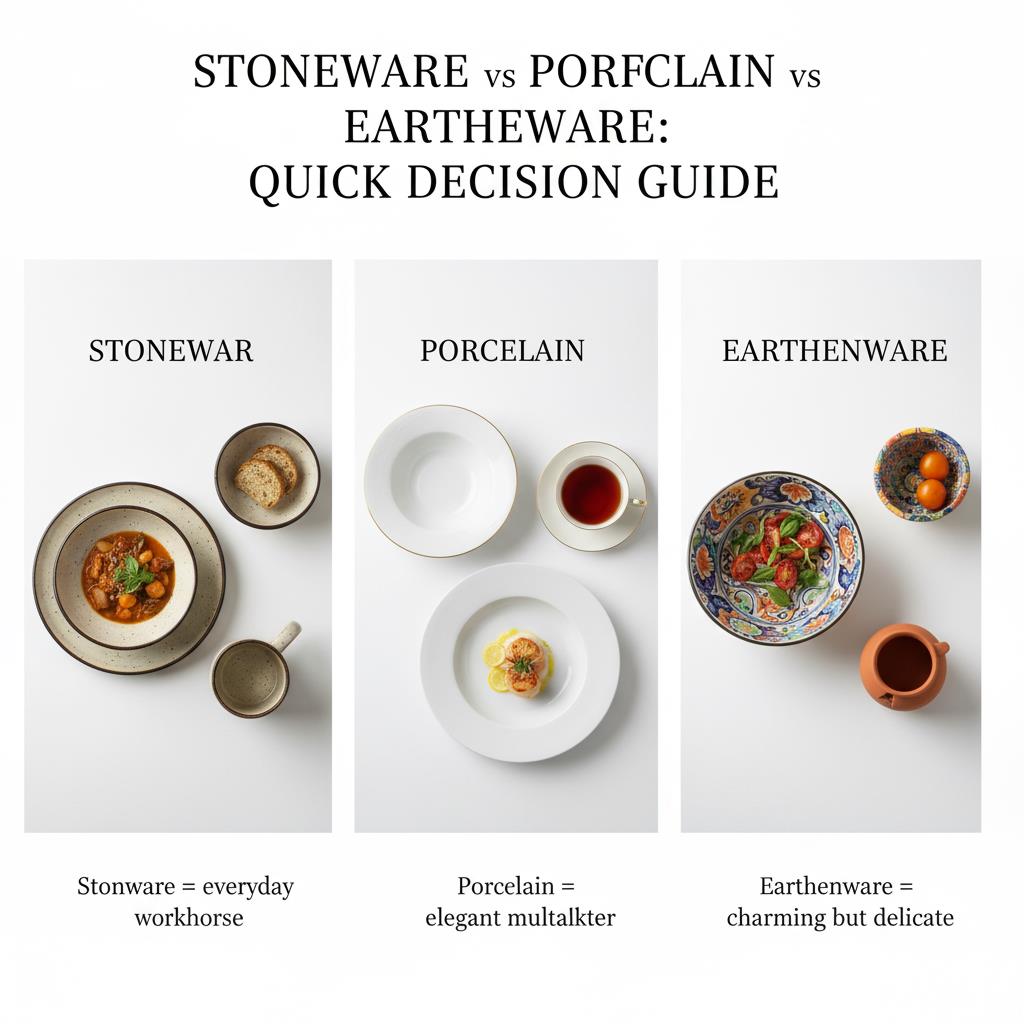
Stoneware vs porcelain, vs earthenware are the three main types of ceramic dinnerware you’ll find today. Stoneware is tough and practical, porcelain is elegant yet durable, and earthenware is affordable with a cozy, handmade feel, but is more delicate. Each of the types is different in how they are made, strength, durability, appearance, and weight.
Porcelain is the elegant of them all. They are heated at high temperatures, so they are lighter. Perfect for everyday to special occasions, the only drawback is that they are easy to crack. On the other hand, stoneware is durable, chip-resistant, and has a textured finish. They are perfect to keep your food warm for a long time. Earthenware has a cozy, rustic feel, often with colorful designs, but it’s more fragile than the other two.
At Global Reach Ceramic, we’ve seen how the right dinnerware can elevate your table. Our goal is simple: to help you choose pieces that aren’t just beautiful but also practical for your everyday life.
Stoneware vs Porcelain vs Earthenware: Differences at a Glance
| Stoneware | Porcelain | Earthenware | |
| Strength | Durable, chip-resistant, solid feel | Strong but light, surprisingly tough | Fragile, chips more easily |
| Look | Rustic, earthy, often speckled or matte | Smooth, elegant, sometimes translucent | Warm, colorful, handmade vibe |
| Weight | Heavier, sturdy in the hand | Thin, light, easy to stack | Medium, can feel chunky |
| Heat | Holds heat well for longer meals | Handles heat evenly, cools faster | Doesn’t like sudden temperature changes |
| Cost | Mid-range, good balance of price and durability | Higher, considered a premium choice | Usually the most affordable |
| Best Use | Everyday dinnerware and baking dishes | Both daily use and special occasions | Decorative or casual, budget sets |
Quick guide:
- Stoneware = everyday workhorse
- Porcelain = elegant multitasker
- Earthenware = charming but delicate
Why The Material Matters
Plates might all look the same at first glance, but trust me, the material changes everything. Think about it: do you want dishes that can survive family spaghetti nights, or ones that feel sleek and elegant when friends come over? Stoneware gives you that solid, down-to-earth feel and keeps food warmer for longer. Porcelain is lighter in the hand, looks polished, and still holds up surprisingly well in everyday use. Earthenware? That’s your rustic, artsy option, Bright, handmade, full of charm but it does need a little extra TLC.
The point is, material isn’t just about style. It affects durability, how much care your dishes need, and even the vibe at your table. Choosing the right one means your dinnerware actually fits the way you live, not just the way it looks in the store.
What is Stoneware?
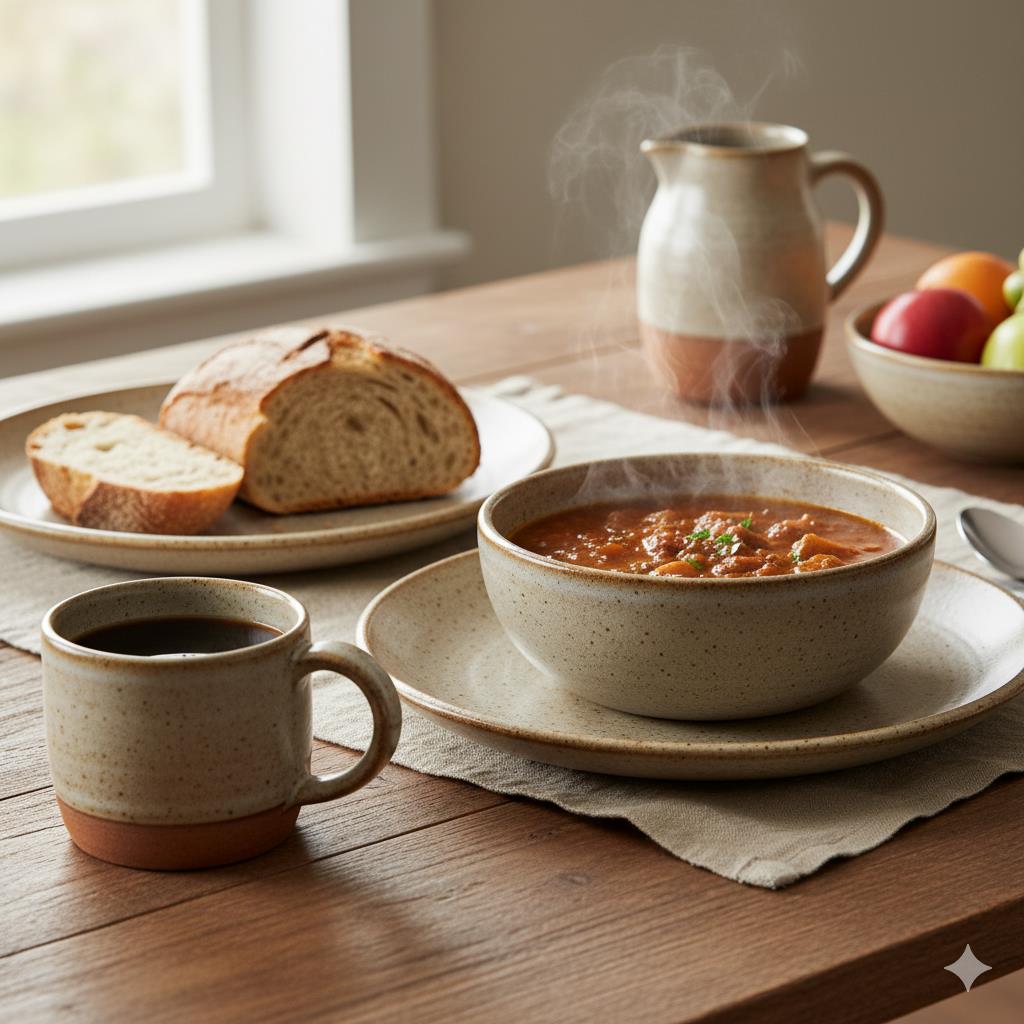
Ever sipped coffee from a heavy, cozy mug that just felt right in your hands? That’s probably stoneware. It’s been around for centuries and got its name because once it’s fired in a hot kiln, over 2,000°F. It becomes as tough as stone. Pretty cool, right?
Stoneware starts with natural clay mixed with a few minerals, shaped into dishes, and then fired until it’s dense and strong. Unlike cheaper clay plates, it won’t soak up water or flavors, which makes it perfect for everyday life. You’ll see it in dinner plates, mixing bowls, baking dishes, and of course, those trusty mugs.
What makes stoneware extra lovable is its look. It often has earthy tones, speckles, or a matte finish that gives your table a relaxed, rustic vibe. If you want something durable but still stylish, stoneware is definitely your friend in the kitchen.
What is Porcelain?
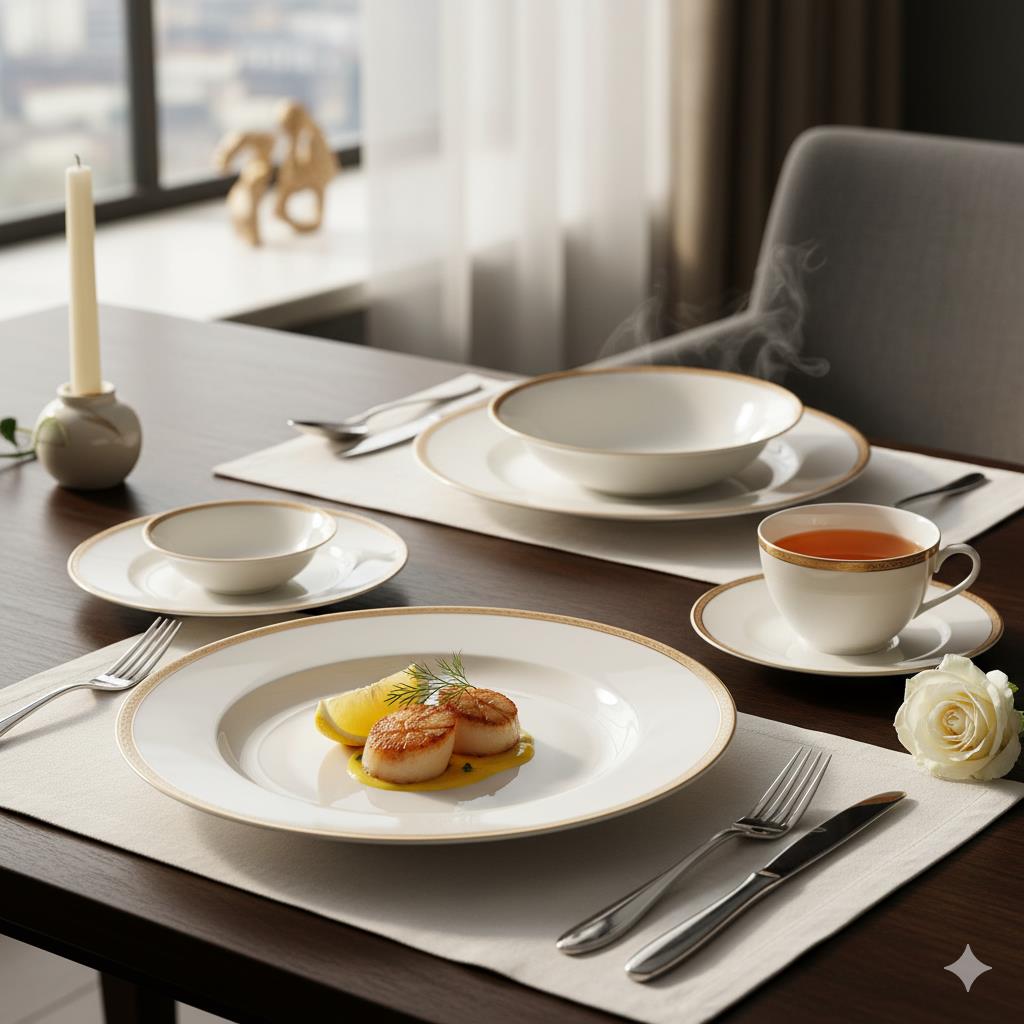
Porcelain is the type of dinnerware that feels smooth, light, and a little fancy. It was first made in China hundreds of years ago and became popular everywhere because of its strength and beauty. To make it, people use a very fine white clay called kaolin, mix it with minerals, and fire it in a kiln at extremely high heat. This process makes porcelain strong, glass-like, and safe to use every day.
Even though porcelain looks delicate, it’s actually tougher than it seems. It doesn’t soak up water, it’s resistant to stains, and it can last for years without losing its shine. If you hold a thin piece up to the light, you might even see it glow a little, that’s one of its unique traits.
Porcelain is perfect if you love dinnerware that’s durable enough for daily use but polished enough for special occasions. It’s the “best of both worlds” option for your table.
What is Earthenware?
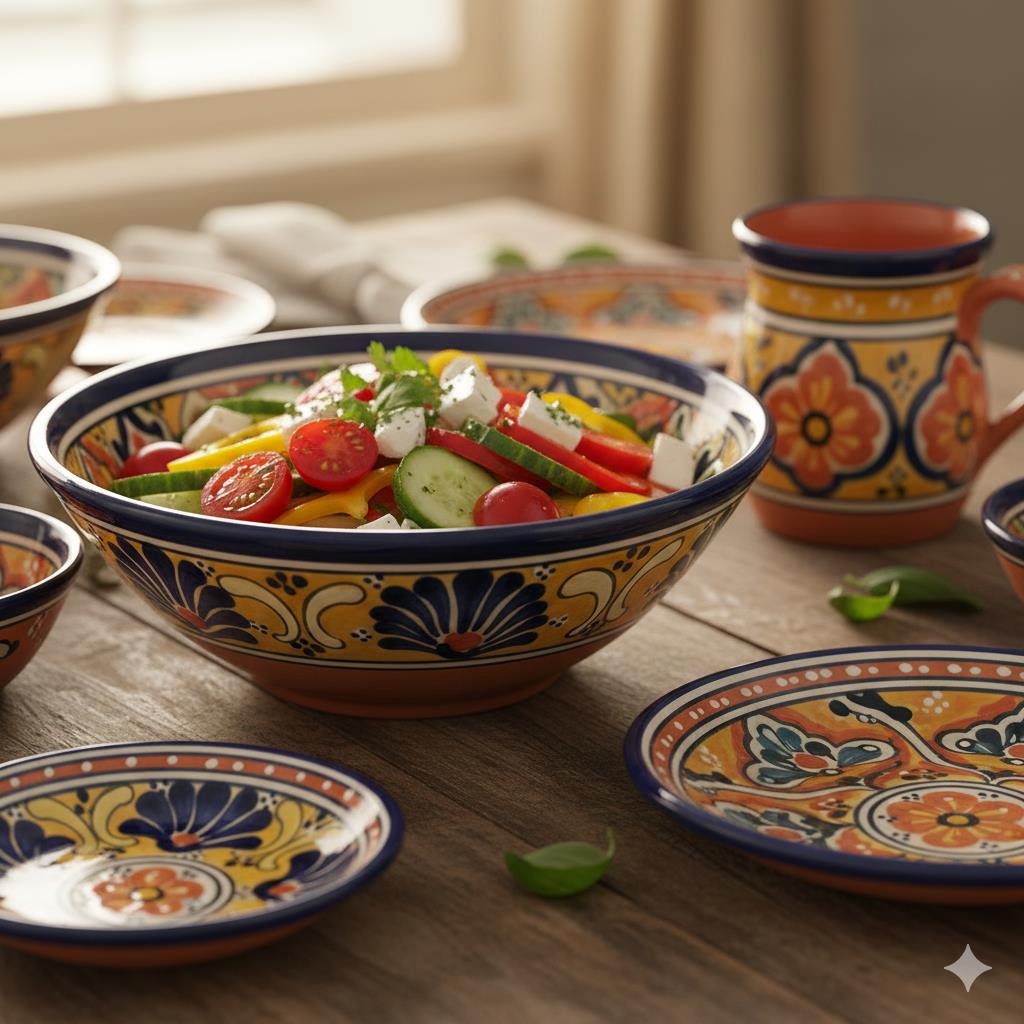
Earthenware is the oldest type of ceramic, and people have been making it for thousands of years. Think clay pots, rustic bowls, and bright, hand-painted plates. It starts as simple clay, shaped and then fired at lower heat, usually under 2,000°F. Because the heat isn’t as intense, the clay stays a little porous and softer than stoneware or porcelain. That’s why most earthenware is covered in a glaze to seal it up.
What makes earthenware special? Its charm. It often has a warm, handmade look and comes in lots of colors and patterns. The flip side is durability. It’s not as tough as stoneware or porcelain. Drop it on the floor, and chances are it won’t survive.
Still, if you love character and don’t mind treating your dishes with a bit of care, earthenware brings personality and cheer to the table.
A Detailed Comparison of Stoneware vs Porcelain vs Earthenware
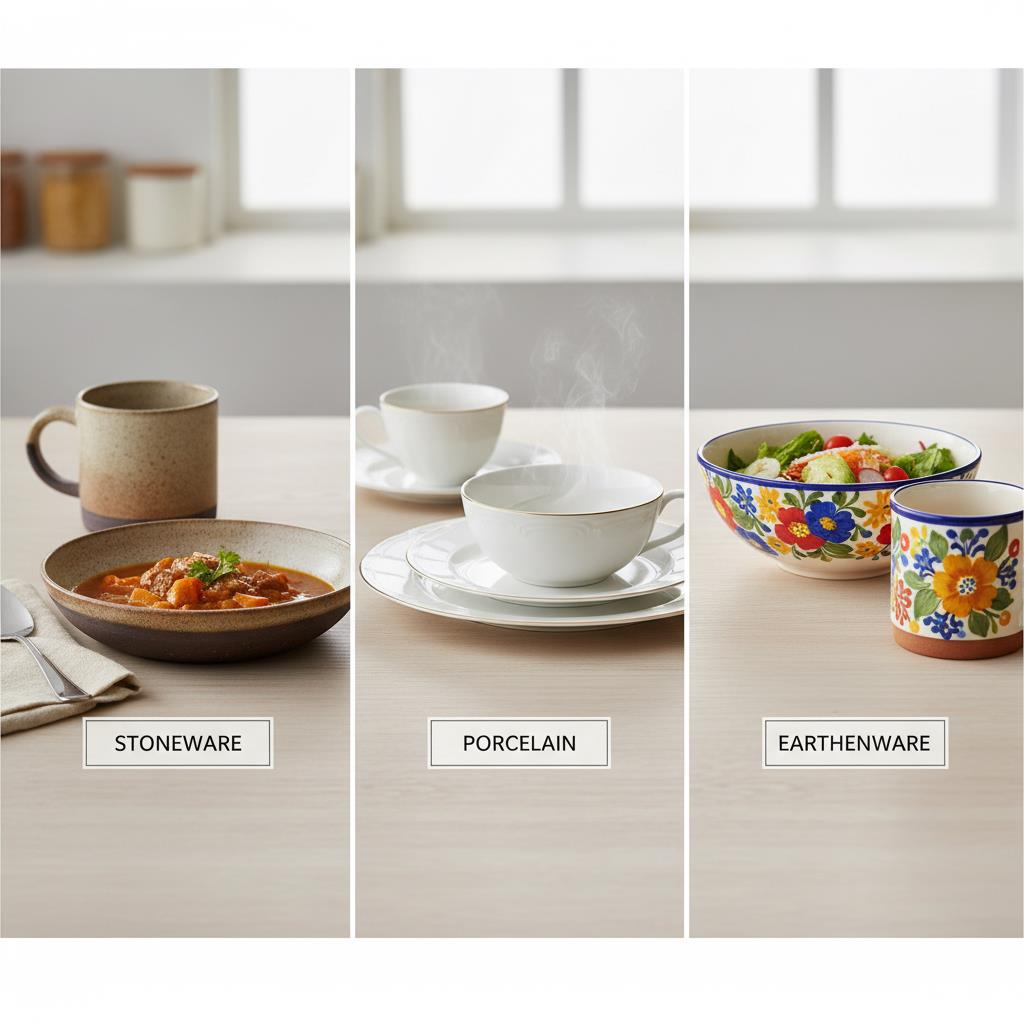
So you’re trying to figure out the difference between stoneware, porcelain, and earthenware? Let’s break it down in plain English.
How They’re Made
Earthenware is the simplest of the three. It’s fired at a lower heat, so it stays softer and more porous. Stoneware goes through hotter firing, which makes it sturdier and denser. Porcelain takes the hottest firing of all, turning it into a strong, glassy material that feels smooth and refined.
Porosity and Absorbency
Earthenware is like the thirsty one. It soaks up water and stains unless it’s glazed. Stoneware is better sealed, though a chip in the glaze can still let moisture in. Porcelain is the star here: completely vitrified, practically waterproof, and super easy to keep clean.
Texture and Appearance
Earthenware looks warm and handmade, often colorful or rustic. Stoneware feels cozy and solid, sometimes with speckles or matte finishes. Porcelain is the polished one, sleek, smooth, and even a little translucent if you hold it up to the light.
Durability and Everyday Use
If you drop earthenware, it probably won’t survive. Stoneware, though, can handle everyday bumps and scrapes and still look good. Porcelain may look delicate, but it’s actually the toughest. It lasts for years without losing its shine.
Weight and Handling
Stoneware is heavy, you feel that solid weight in a mug or plate. Porcelain is light, easy to stack, and comfortable to carry around. Earthenware lands somewhere in between, though glazed pieces can feel a bit chunkier.
Heat and Thermal Shock
Stoneware is great at keeping food warm. Your soup or casserole will stay cozy longer. Porcelain heats evenly and works well for both hot meals and chilled desserts. Earthenware? It needs a gentle touch. Quick changes from hot to cold can make it crack, so don’t shock it.
Price Point
Earthenware is the budget-friendly option with lots of charm. Stoneware gives you durability without breaking the bank. Porcelain is usually the priciest, but you’re getting elegance and serious staying power.
Safety and Regulations for Dinnerware
Dinnerware isn’t just about style; it also needs to meet certain safety standards so your meals stay healthy. The biggest concern with ceramic pieces is usually the glaze. In the past, glazes sometimes contained lead or cadmium, which could slowly leach into food. Acidic dishes, such as tomato sauce, citrus, or vinegar, can make that process faster. Today, most reputable brands follow strict rules, but it’s still smart to look for labels like “food safe” or “lead-free.”
In the U.S., the Food and Drug Administration (FDA) regulates ceramic dinnerware and sets limits on how much lead or cadmium can migrate from the glaze. California also has its own standard, Proposition 65, which requires companies to warn consumers if their product contains certain chemicals. A Prop 65 label doesn’t always mean the piece is unsafe. iI simply means the manufacturer is being transparent.
Practical Considerations Before Buying Dinnerware
How Will You Use It?
Do you need tough plates for everyday meals, or are you more about setting a fancy table for guests? Stoneware is sturdy and forgiving, porcelain brings that classy feel while still being strong, and earthenware is charming but a bit more delicate.
Microwave and Dishwasher Check
Hate hand-washing? Most stoneware and porcelain are safe for the dishwasher and microwave, but always peek at the label to be sure. Earthenware can be trickier, doesn’t always love heat or water, so some pieces need extra care.
Space, Weight, and Style
Stoneware is solid and heavy, porcelain is light and neat, and earthenware often feels cozy and handmade. Think about your cupboard space and the vibe you want at the table.
Budget and Longevity
If you’re keeping an eye on cost, earthenware is often the most affordable choice. Stoneware is a little pricier but lasts longer, making it a good balance between value and durability. Porcelain usually costs the most, but it also gives you that classic, timeless look that can last for decades if cared for properly.
Care and Maintenance Guide for Dinnerware
Stoneware
- Most stoneware is dishwasher- and microwave-safe, but always check the label.
- Avoid sudden temperature changes, such as moving a dish from the fridge straight into a hot oven.
- Hand-washing with mild soap helps preserve the glaze and finish.
Porcelain
- Usually safe for both the dishwasher and microwave.
- Clean with a soft sponge instead of abrasive scrubbers to protect the glossy surface.
- Rinse soon after serving colorful foods like curry or tomato sauce to prevent stains.
Earthenware
- Do not soak for long periods, as earthenware is porous.
- Hand-wash gently and dry thoroughly before putting it away.
- Avoid exposing it to rapid temperature changes, which can cause cracks.
General Tips
- Stack dishes carefully; placing a cloth or paper towel between plates prevents scratches.
- Do not store food long-term in earthenware, since it can absorb liquids and odors.
- Always follow the care instructions provided by the manufacturer.
Quick Decision Guide: Porcelain or Stoneware, or Earthenware?
Think about what matters most to you. Start with your top priority if two feel equal, check the next row.
| What You Care About | Best Choice | Why It Works | Quick Tip |
| Strong for daily use | Stoneware | Thick and tough, handles bumps and knocks well | Look for “chip-resistant” sets |
| Light and easy to lift | Porcelain | Slim walls make plates lighter and easier to stack | Great for tight cabinets |
| Warm, rustic style | Earthenware | Cozy, handmade look with colorful or earthy finishes | Perfect for casual, homely tables |
| Food stays hot longer | Stoneware | Heavy body keeps heat in your food | Warm the plates before serving |
| Clean, fancy look | Porcelain | Shiny, bright, and elegant for special or formal meals | Works well for guests and photos |
| Cheapest option | Earthenware | Usually, the lowest price of the three | A good starter choice |
| Good mix of price + strength | Stoneware | Affordable and durable for everyday family use | A 16-piece set is often enough |
| Luxury feel | Porcelain | Thin, fine, or decorated designs look high-end | Check care instructions carefully |
Simple rule of thumb: stoneware = sturdy everyday, porcelain = light and elegant, earthenware = rustic and budget-friendly.
Frequently Asked Questions (FAQ)
Why is porcelain more expensive than stoneware?
Porcelain uses finer clay, is fired at higher temperatures, and has a smoother, refined finish, making it stronger and more elegant.
What is earthenware best used for?
Earthenware is great for decorative pieces and colorful, casual dinnerware, but it’s less ideal for heavy daily use.
Is the stoneware dishwasher and microwave safe?
Most modern stoneware is safe for both, but always check the label, as some glazes or finishes may be sensitive.
Can porcelain go in the oven?
Yes, many porcelain dishes are oven-safe, but thin or delicate pieces should be handled with care. Always check the manufacturer’s instructions.
Does earthenware absorb water?
Yes. Earthenware is more porous, which is why it’s usually glazed. Even then, it may still absorb some moisture over time.
Which material lasts the longest?
Porcelain generally lasts the longest because it’s fully vitrified, highly durable, and resistant to scratches and stains.
Is earthenware food safe?
Modern earthenware that’s properly glazed and labeled “food safe” is safe to use. Avoid old or untested pieces, as they may contain lead.
Final Thoughts
So, we’ve talked through stoneware vs porcelain vs earthenware and by now, you probably see that there isn’t one “perfect” answer. It really comes down to what fits your life best. Stoneware is that solid, dependable friend you can count on every day. Porcelain has the sleek, elegant vibe that works just as well for a casual lunch as it does for a dinner party. And earthenware? It’s full of charm and personality, perfect if you love a handmade, cozy feel.
Here at Global Reach Ceramic, we honestly love helping people find dinnerware that feels right for them. Not just what looks good in the store, but what actually makes mealtimes easier and more enjoyable.
RECENT POSTS
- The Impact of Ceramic Materials in Energy-Efficient Buildings: Benefits and Applications
2025-12-04
- Top 7 Ceramic Cookware Health Benefits: Why It’s a Safer Choice for Your Kitchen
2025-12-04
- How to Clean Ceramic Planters and Improve Their Lifespan?
2025-11-17
- 15 Best Ceramic Holiday Gift Ideas for 2025: Thoughtful, Elegant & Heartfelt
2025-11-17
- Stoneware vs Porcelain vs Earthenware: Quick Decision Guide
2025-10-09
- Are Ceramic Glazes Food Safe? The Truth Behind the Shine
2025-10-09
- Christmas Decoration Trends That Wow Every Guest
2025-09-18
- Halloween Decoration Trending Ideas with Ceramics For 2025-26
2025-09-18










